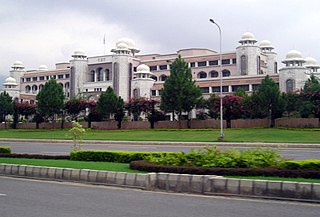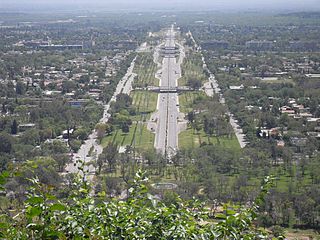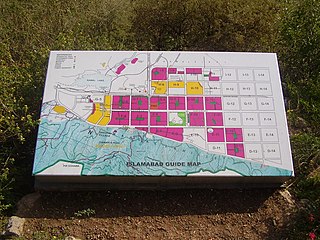
Sectors of Islamabad are administrative divisions of Zone I and Zone II of the Islamabad Capital Territory region. The capital territory is divided into 5 zones, of which Zone I and Zone II have been designated urban development zones. [1]

Sectors of Islamabad are administrative divisions of Zone I and Zone II of the Islamabad Capital Territory region. The capital territory is divided into 5 zones, of which Zone I and Zone II have been designated urban development zones. [1]

Each square shaped sector is named by combining Latin letters and numerals together. The sector letters increase north to south from A to O, while sector number increases east to west from 1 to 20. However, at present time, sectors A to I and 5 to 18 are currently open for urban development.
This is a list of all planned and constructed sectors. [2]

The Islamabad Capital Territory is the only federal territory of Pakistan and contains Islamabad, the capital of Pakistan. Located on the northern edge of the Pothohar Plateau and at the foot of the Margalla Hills, The ICT shares borders with the province of Khyber Pakhtunkhwa in the west and with the province of Punjab in the remaining directions. It covers an area of 906.5 square kilometres and according to the 2023 national census, has a population of over 1 million in the city proper, while over 2 million in the whole territory. The territory is represented in the National Assembly by NA-52, NA-53, and NA-54 constituencies and by four seats in the Senate.

Islamabad is the capital city of the Islamic Republic of Pakistan. It is the country's ninth-most populous city with a population of over 1.2 million people and is federally administered by the Pakistani government as part of the Islamabad Capital Territory. Built as a planned city in the 1960s and established in 1967, it replaced Karachi as Pakistan's official national capital.

Blue Area is the central business district of Islamabad, Pakistan along the Jinnah Avenue. The area is a 2-kilometer (1.2 mi)-long corridor along Islamabad's Khayaban-e-Quaid-e-Azam, Islamabad's primary arterial road which leads up to the main government buildings. It is characterized by clean, wide roads and tall buildings among the panoramic greenery of the adjacent areas.

Fatima Jinnah Park, also known as Capital Park or F-9 Park, is a public recreational park that spans the whole of Sector F-9 of Islamabad, Pakistan. It is named after Mādar-e Millat Fatima Jinnah, the younger sister of the founder of Pakistan Muhammad Ali Jinnah.

Islamabad, the capital of Pakistan, is home to numerous tourist attractions. Daman-i-Koh, Margalla Zoo, Pakistan Monument, Faisal Mosque, Shakarparian, Lok Virsa Museum and Rawal lake view point are among the top tourist attractions in Islamabad. It also acts as a stop for journeys to Murree and Northern Pakistan when travelling from Pakistani provinces of Punjab, Sindh, and sometimes even Balochistan.

Islamabad is located in the Pothohar Plateau in the northern part of Pakistan, within the Islamabad Capital Territory. It is a well-organized city divided into different sectors and zones. It was ranked as a Gamma + world city in 2020. The city is home to Pakistan Monument, which is built on top of a hill in Shakarparian, and the Faisal Mosque, one of the largest mosques in South Asia and the sixth -largest mosque as per area in the world. The Capital Development Authority is tasked with developing the city and its facilities.

Seventh Avenue, also known as the Ahmed Nadeem Qasmi Avenue, is a signal free road located in Islamabad. It starts from the intersection on Khayaban-e-Iqbal near Islamabad Zoo, and ends at the intersection on Srinagar Highway.

Ninth Avenue also known as Agha Shahi Avenue, named after Pakistani statesman Agha Shahi, is a partially signal free road located in Islamabad. It was inaugurated by the then CDA chairman Kamran Lashari on 25 February 2008.
Ayub Market, also known as F-8 Markaz is a commercial center located in Sector F-8, Islamabad. The market is mainly occupied by District courts, government offices of the Islamabad Capital Territory Administration and Margalla police station. There is also a foreigners registration center in the market.

Melody Market or G-6 Markaz or Civic Center is a commercial center and market area located in Sector G-6, Islamabad. The area also houses National Bank of Pakistan's headoffice.

B-17 is a sector of Islamabad, Pakistan., developed by Multi-Professional Cooperative Housing Society (MPCHS). The sector is bounded on the east by N-5 National Highway and with the M-1 motorway to the west. B-17 is a newly developing sector located in Zone II of Islamabad Capital Territory. CDA approved and issued no objection certification (NOC) to MPCHS for sector B-17 on 30 January 2008, besides NOC was issued by Federal Directorate of Education (FDE) for construction of schools in the society.

I-11 is a sector of Islamabad, Pakistan. It is a lightly built area, located on the southwestern edge of the city. I-11 borders Rawalpindi to the south and neighbors I-10 and I-12, while sectors H-10, H-11 and H-12 are located adjacent. CDA has taken the possession of land from illegal encroachers and land grabbers and development work has started to hand over the possession to original owners of the plots.

The Islamabad–Rawalpindi metropolitan area is the fourth-largest metropolitan area of Pakistan, after Karachi, Lahore, and Faisalabad. It consists of the twin cities of Islamabad and Rawalpindi.

F-8 is a sector of Islamabad. The sector is bounded by Margalla Avenue and E-8 to the north, Faisal Avenue and F-7 to the east, Jinnah Avenue and G-8 to the south, and Ninth Avenue and F-9 to the west.
F-6 is a sector of Islamabad. The sector is located at the foothills of Margalla Hills of Islamabad.

The Margalla Avenue or Margalla Expressway is a 33-kilometer six-lane highway in the Margalla Hills area in the suburbs of Islamabad, Pakistan. It was planned in 1966, but work on it was stalled till 2021. The road is an alternative to the Srinagar Highway, and provides easy access of the tenth and eleventh sectors of Islamabad to the N-5 National Highway. This road is a crucial section of the larger Rawalpindi Ring Road project as it connects the town of Sangjani to the town of Barakahu.

H-8 is a sector of Islamabad. The sector is bounded by Srinagar Highway and G-8 to the north, Islamabad Expressway and Shakarparian to the east, I-8 to the south, and Ninth Avenue and H-9 to the west.